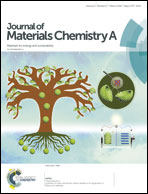An efficient solar-enabled 2D layered alloy material evaporator for seawater desalination
Abstract
Solar energy-driven seawater desalination is a facile, green, and low-cost strategy to address the energy and fresh water crisis. 2D layered alloy materials (2DLAMs) have aroused significant interest in this field due to their strong light–matter interaction, abundant intermediate band states, and superior stability. Herein, we demonstrated an efficient self-floating solar-enabled 2DLAM evaporator for the first time for seawater desalination. It is achieved by depositing layered BiInSe3 onto carbon foam (CF) via one-step pulsed-laser deposition. Importantly, the BiInSe3@CF device exhibits an evaporation rate of 1.1 kg m−2 h−1 upon 1 sun irradiation (1 sun = 100 mW cm−2), which is one of the highest values reported to date. In addition, ion concentrations of the resulting water decrease by four orders of magnitude, which are much lower than the upper limit of the drinking water standards of the World Health Organization and the US Environmental Protection Agency. Moreover, the device demonstrates good reusability with no observable degeneration in 15 cycles over a period of 15 days. This high-performance seawater desalination capability is attributed to the synergistic effect of excellent light absorption, abundant phonon-assisted decay, and superior localized interfacial heating. These findings suggest that the functional design of the floatable 2DLAM evaporator represents a convenient and efficient route to achieve high-quality seawater desalination.



 Please wait while we load your content...
Please wait while we load your content...